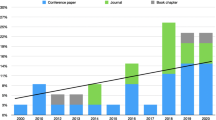Abstract
The public often relies on social media to discuss and organize activities such as rallies and demonstrations. Monitoring and analyzing open-source social media platforms can provide insights into the locations and scales of rallies and demonstrations, and help ensure that they are peaceful and orderly.
This chapter describes a dictionary-based, semi-supervised learning methodology for obtaining location information from Chinese web forums. The methodology trains a named entity recognition model using a small amount of labeled data and employs n-grams and association rule mining to validate the results. The validated data becomes the new training dataset; this step is performed iteratively to train the named entity recognition model. Experimental results demonstrate that the iteratively-trained model has much better performance than other models described in the research literature.
Access this chapter
Tax calculation will be finalised at checkout
Purchases are for personal use only
Preview
Unable to display preview. Download preview PDF.
Similar content being viewed by others
References
A. Breuer, The Role of Social Media in Mobilizing Political Protest: Evidence from the Tunisian Revolution, Discussion Paper No. 10/2012, German Development Institute, Bonn, Germany, 2012.
R. Collobert, J. Weston, L. Bottou, M. Karlen, K. Kavukcuoglu and P. Kuksa, Natural language processing (almost) from scratch, Journal of Machine Learning Research, vol. 12(2011), pp. 2493–2537, 2011.
S. Eddy, Hidden Markov models, Current Opinion in Structural Biology, vol. 6(3), pp. 361–365, 1996.
Government of Hong Kong, Government Response to Public Meeting in Victoria Park, Hong Kong, China (www.info.gov.hk/gia/general/201908/18/P2019081800818.htm), August 18, 2019.
J. Hammerton, Named entity recognition with long short-term memory, Proceedings of the Seventh Conference on Natural Language Learning, pp. 172–175, 2003.
Z. Huang, X. Wei and K. Yu, Bidirectional LSTM-CRF Models for Sequence Tagging, arXiv: 1508.01991 (arxiv.org/abs/1508.01991), 2015.
J. Lafferty, A. McCallum and F. Pereira, Conditional random fields: Probabilistic models for segmenting and labeling sequence data, Proceedings of the Eighteenth International Conference on Machine Learning, pp. 282–289, 2001.
F. Lee, H. Liang, E. Cheng, G. Tang and S. Yuen, Affordances, movement dynamics and a centralized digital communication platform in a networked movement, to appear in Information, Communication and Society, 2021.
J. Li, A. Sun, J. Han and C. Li, A survey of deep learning for named entity recognition, to appear in IEEE Transactions on Knowledge and Data Engineering, 2021.
LIHKG, LIHKG Online Forum, Hong Kong, China (lihkg.com), 2021.
W. Liu, T. Xu, Q. Xu, J. Song and Y. Zu, An encoding strategy based word-character LSTM for Chinese NER, Proceedings of the Conference of the North American Chapter of the Association for Computational Linguistics: Human Language Technologies, Volume 1 (Long and Short Papers), pp. 2379–2389, 2019.
A. McCallum, D. Freitag and F. Pereira, Maximum entropy Markov models for information extraction and segmentation, Proceedings of the Seventeenth International Conference on Machine Learning, pp. 591–598, 2000.
M. Purbrick, A report on the 2019 Hong Kong protests, Asian Affairs, vol. 50(4), pp. 465–487, 2019.
X. Tang and C. Song, Microblog public opinion analysis based on complex networks, Journal of the China Society for Scientific and Technical Information, vol. 31(11), pp. 1153–1163, 2012.
C. Yang and T. Ng, Analyzing and visualizing web opinion development and social interactions with density-based clustering, IEEE Transactions on Systems Man and Cybernetics – Part A: Systems and Humans, vol. 41(6), pp. 1144–1155, 2011.
T. Zeitzoff, How social media is changing conflict, Journal of Conflict Resolution, vol. 61(9), pp. 1970–1991, 2017.
Y. Zhang and J. Yang, Chinese NER Using Lattice LSTM, arXiv: 1805.02023 (arxiv.org/abs/1805.02023), 2018.
Y. Zhu, G. Wang and B. Karlsson, CAN-NER: Convolutional Attention Network for Chinese Named Entity Recognition, arXiv: 1904.02141 (arxiv.org/abs/1904.02141), 2020.
Author information
Authors and Affiliations
Corresponding author
Editor information
Editors and Affiliations
Rights and permissions
Copyright information
© 2021 IFIP International Federation for Information Processing
About this paper
Cite this paper
Qin, S., Wen, Q., Chow, KP. (2021). PREDICTING THE LOCATIONS OF UNREST USING SOCIAL MEDIA. In: Peterson, G., Shenoi, S. (eds) Advances in Digital Forensics XVII. DigitalForensics 2021. IFIP Advances in Information and Communication Technology, vol 612. Springer, Cham. https://doi.org/10.1007/978-3-030-88381-2_9
Download citation
DOI: https://doi.org/10.1007/978-3-030-88381-2_9
Published:
Publisher Name: Springer, Cham
Print ISBN: 978-3-030-88380-5
Online ISBN: 978-3-030-88381-2
eBook Packages: Computer ScienceComputer Science (R0)





